An estimated 3 million Poles left their country between 1850 and 1914. The most common direction of their emigration was Chicago in the United States. As a result, the second biggest population of Polish people still lives in this city today, outside Poland! How did it happen that people from Polish lands started to migrate to America in the 19th century?
Łukasz Kożuchowski: The fact that the biggest Polish city is Warsaw is quite obvious. But the fact that the second biggest population of Polish people (ca. 1,5 million) lives outside Poland – in Chicago – may come as a surprise to many. How did it happen that people from Polish lands started to migrate to America in the 19th Century?
Dominic Pacyga: After 1840 the Polish lands went through several changes that transformed all three of the partitions. This included peasant emancipation and the granting of land to peasants, the cutting off of traditional markets for Polish agricultural products in Western Europe, the expansion of the capitalist and industrial market system to Central and Eastern Europe. Comparably important was the growth of the vast transportation networks, especially railroads. After 1850 they opened up the interior of Europe east of the Elbe River. In addition, transatlantic travel was greatly improved in speed and safety. All of these provided Polish peasants with a great deal of mobility. Many left Polish villages for American, German, French cities and Brazilian farms creating a vast diaspora. In turn they often planned to return after making their fortunes, and helping their families expand their land holdings. They also sent a good deal of money back to their villages to help their relatives.
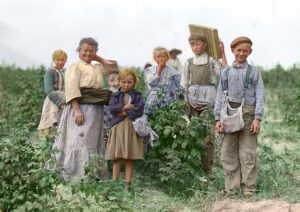
As I have mentioned, many migrants chose Chicago as their destination. Why exactly this city?
Chicago was the fastest growing city in the United States in the 19th century. After the American Civil War, it developed as an industrial and railroad centre. Large mass production industries such as garment manufacturing, meat packing and steel settled in the city. In addition, a wide variety of other industries developed in Chicago. All of these needed both skilled and unskilled labour and attracted wave after wave of immigrants. The opportunities afforded in Chicago and other U.S. industrial centres powered this Polish economic migration.
When did the first significant wave of Polish immigration occur?
The first wave of Polish immigration to the United States began in the 1850s. These first immigrants tended to come from the Prussian Partition. This migration reached its greatest height in the 1870s. At the end of the decade, Wielkopolska suffered a population loss of 41,000. By the end of the next decade this migration to the United States began to lessen and the emigration of Poles from the Russian partition increased. Between 1890 and 1892 approximately 70,000 left the Congress Kingdom. After 1900, the Galician emigration gained momentum and supplied the greatest numbers going to the United States. In the period 1899 to 1910 some half a million Poles left Galicia for the United States. The greatest single year of outgoing migration from the area was 1910, when over 60,000 people departed.
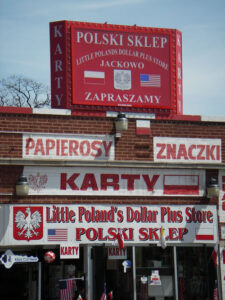
Many immigrants first came to other settlements including the Polish Silesian colony in Panna Maria (“Our Lady”), Texas. In the history of American immigration, those from the Polish lands are included in the second wave of European immigration from Eastern and Southern Europe. Besides this large “za chlebem” (“after bread”) migration, there have been at least two other major periods of Polish immigration to the United States and Chicago. The second large immigration took place after World War II when many Poles joined other people displaced by the war. In the late 1980s another migration, a result of the years of struggle between the Solidarity labour union and the Communist regime occurred. Smaller immigrations took place in the interwar period and during the Cold War.
When did the number of migrants coming from Poland to America reach its peak? Were there some kind of waves of migrant influx to the US?
In the last half of the nineteenth century, changes in economic and social conditions in Poland motivated large numbers of people to emigrate. An estimated 3 million Poles left between 1850 and 1914. The American migration, which was the largest, was only part of the greater movement of Poles to areas in Europe, Asia, and the Western Hemisphere. Polish migration to America peaked between the years 1890 and 1914. The largest numbers came in 1912, just before the outbreak of World War I, when roughly 175,000 people entered the country from all parts of Poland. Perhaps the most reliable estimate states that between 1,148,649 and 1,780,151 Poles entered America between 1899 and 1932. In 1920 it was calculated that there were approximately 3 million inhabitants of Polish heritage in the United States. By 1930 the U.S. Census counted 4,227,734 Poles.
What did a journey to America look like for such a late 19th and early 20th century migrant? What difficulties awaited those who decided to take up such a journey?
By the time immigrants reached Chicago they had a long and tiresome journey behind them. The immediate problem for Polish emigrants from areas outside the German Empire was to cross the imperial frontiers so as to reach the great ports of Northern and Western Europe. As Polish emigration reached its peak, the German ports of Hamburg and Bremen had the most embarkations for the United States. After 1892, the German government involved itself more in immigrant traffic by setting up control stations at its eastern borders. Germany instituted these checkpoints out of fear that immigrants would carry cholera from the interior to the ports. The increased complexity of American health regulations made it more important to deal effectively with illness and other physical or mental deficiencies at the ports, or even earlier at the frontiers. In 1907 authorities rejected almost 12,000 people at the German border and nearly 40,000 at the various ports, leaving 13,000 for American inspectors to turn back at Ellis Island in New York.
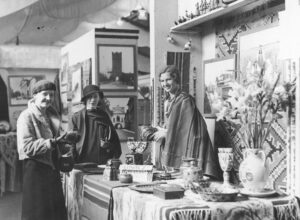
One of the border control stations was located at Mysłowice at the junction of the German, Russian, and Austrian empires in Poland. Both Austrian and Russian Poles passed through that station to reach the German ports. At the control stations emigrants walked through a narrow corridor where they met three men: an agent of the steamship lines, a Russian policeman, and a German officer. The emigrant gave his or her tickets to the agent and then entered a large hall. The Germans kept Austrian and Russian Poles separate. In addition, Polish Jews were segregated on the trains. These trains took emigrants to Berlin and they then boarded another train to Bremen or Hamburg. Port cities could be very expensive and offered various temptations to young emigrants. Once they left the ports it took roughly ten days to two weeks to cross the Atlantic to New York City where they were processed and then another two-day trip by train to Chicago. At New York, barges brought immigrants from the ships to Ellis Island, where attendants guided them into the inspection lanes. Immigration authorities required immigrants to pass another physical and mental examination at the point of disembarkation. Compare this to today’s more comfortable process of boarding a jet in Warszawa or Kraków and landing in Chicago in ten hours.
The migrants must have been bewildered by the tiresome journey and specific realities of their new home country. How would immigrants start to settle, once they arrived in Chicago?
That’s true, the arrival in Chicago could be a bewildering experience. The train station itself was a source of confusion. Other kinds of rail traffic often sidetracked the immigrant trains. It was hard to meet those that arrived behind schedule. Furthermore, the great crowds in Chicago made it difficult to find waiting friends and relatives. Some of the immigrants discovered on arrival that they did not have the full or proper address. The trip from the train station to the various Polish neighborhoods took place on the city’s vast and confusing public transportation system. The newcomer had to find food, shelter, and employment. In order to deal with these problems, different groups created an informal system connecting the various settlements in Europe and America.
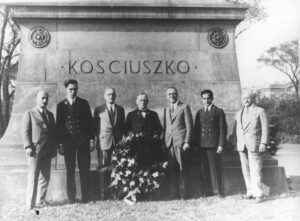
Often the immigrant who came to the United States arrived on a prepaid ticket. Polish immigrants sent money back to their villages in order to have their family, friends, or fiancés join them. After the first migration had been made from a village, a system of information and mutual aid quickly emerged. Although the village could not be exactly duplicated in the new environment, the would-be immigrant knew that he could find compatriots, or rodacy, in the new settlement who would help him or her to establish themselves in Chicago.
You have mentioned that the migrants wanted to establish relations with other Poles in America. Were there some specific neighbourhoods were Poles gathered? Or did they rather scatter around the city?
Most Poles settled in one of five original Polish neighbourhoods. The first was in West Town now called Wicker Park. In Polish it became known as Stanisławowo and Trójcowo. It was here that the first Polish parish (there would eventually be more than 60 Polish Catholic parishes or parishes that came to be dominated by Poles in Chicago), St. Stanislaus Kostka, was founded in 1867. Holy Trinity parish was organized shortly afterward. The second Polish neighbourhood appeared by the 1870s near 18th and Ashland Avenue in a working-class district known for railroads, lumber yards, and the McCormick Reaper Works. A third neighbourhood appeared in Bridgeport south of Archer Avenue. Two other South Side neighborhoods soon developed in the Back of the Yards just west of the Union Stock Yard and meat packinghouses and another near the steel mills in South Chicago. These original settlements grew quickly and Polish Chicagoans moved to other areas including Avondale, Brighton Park, South Lawndale, Hegewisch among others.
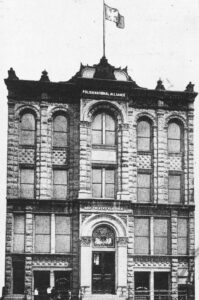
Many migrants took menial jobs in factories. But were there maybe some cases of social advancement?
There was some upward mobility by the original immigrant community. While Polish clergy played important roles in the early intellectual life of the diaspora, Polish American politicians played a central role in the city from the late 19th century onward. Polish intellectuals also migrated to Chicago and organized newspapers and other media. Polish actors and media personnel played in Chicago theaters and later radio and television. Many Polish immigrants proved to be successful businessmen. In the years after World War II, the Polonia witnessed a good deal of upward mobility as more and more Polish Chicagoans went to high schools and universities.
Did the migrants prefer to integrate into the English-speaking society and culture, or did they prefer to stay together with the people from their motherland?
Polish immigrants generally settled in multi-ethnic residential districts, but created insulated communities. They revolved around Catholic parishes, but included a lively business community as well as taverns, newspapers, bookstores, Polish language libraries, theatrical groups, parochial schools, hospitals, funeral parlors and cemeteries. These communities attempted to create a safety net that protected residents from cradle to grave. Of course, they could not be totally self-sufficient since they largely relied on American industry for their economic base. There were several conflicts with other ethnic groups, but also alliances especially with the Czechs. Polish and Lithuanian immigrant communities often fought. So did Poles and Jews. The largest clash with another immigrant group, however, came during World War I when Poles and other Slavic groups, especially the Czechs battled with what was then Chicago’s largest ethnic group, the Germans. Poles would later clash with African Americans and Mexicans.
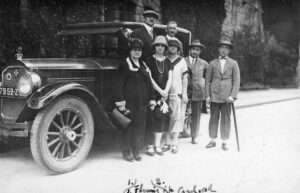
You have mentioned conflicts between Poles and other migrants. As we know, relations between migrants, e.g. Irish or Italian, and the local Anglo-Saxons, could also be harsh. Was it also the case with the Polish migrants?
Despite a very diverse diaspora, Polish immigrants were generally stereotyped as unskilled workers. They often took unskilled positions in factories, mills, and sweatshops. These Polish immigrants felt a good deal of prejudice both as immigrants and as Catholics in what was then a largely Protestant country. Books such as Madison Grant’s The Passing of the Great Race, projected a negative image of Polish immigrants as well as other immigrants from Eastern and Southern Europe.
So how did the migrants cope with such a difficult social situation? Did they organize somehow? Societies, parishes?
Poles organized parishes, and a variety of institutions such as fraternal groups including the Polish National Alliance, the Polish Roman Catholic Union of America, the Polish Women’s Alliance, the Sokol Gymnastic Association, the Polish Highlanders’ Alliance of North America, as well as the Polish Veterans Association among others. Later immigrants would organize the Polish Scouts (Harcerstwo), Polish Veterans of World War II, and the Polish Saturday Schools. Various professional organizations also appeared including the Advocates Society, a Polish American lawyers’ group. Polish doctors, dentists, teachers, and librarians have also created associations. Polish Chicagoans organized banks, savings and loan association, and the Polish Association, a welfare association that provided social services to the community.
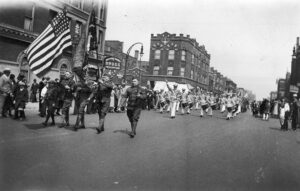
Do Poles in Chicago have their own festivals, such as the Pulaski Parade in New York? How is their culture visible in the cultural mosaic of the city?
For over 100 years the Polish May 3 Constitution Day Parade, reportedly the largest Polish parade in the world, has been held in Chicago. Every year approximately 100,000 Polish Americans march to commemorate the first European constitution. Various other celebrations are held including the Taste of Polonia at the Copernicus Center and Pulaski Day at the Polish Museum of America. Religious holidays are also marked including Corpus Christi, the Feast of the Assumption, and of course Easter and Christmas. In the 19th century Poles often marked the anniversaries of the 1830-31 Polish Russian War and the anniversary of the 1863 Insurrection.
What does the position of the Polish people in Chicago look like nowadays?
The vast majority of both Polish nationals and Polish Americans today live in the suburbs of the city. The old Polish settlements today contain largely Hispanic communities. Although their numbers are largely diminished, many still live in the city.
Is Polish culture, represented by the descendants of the migrants, present in Chicago also today? Or do the younger generations rather blend with the local culture and society?
Over the generations Polish Americans have largely assimilated, although many maintain a sense of “Polishness”. Much of this is seen during the holidays and during the various Polish festivals in Chicago and the suburbs. Ethnicity in Chicago often revolves around food, music, and famous people, but also religious rituals. Polish Chicagoans bless baskets before Easter, although the contents may not always be traditional, share opłatki (traditional Christmas bread) at Christmas, and often display examples of Polish folk art. Unfortunately, by the third generation, the overwhelming number of Polish Chicagoans have largely lost the ability to speak Polish, although many know a few words. Those who do speak Polish often speak a particular dialect that mixes Polish and English words with Polish endings.
Interviewer: Łukasz Kożuchowski





